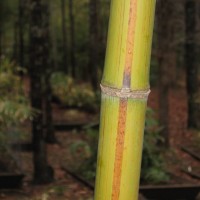WHY BAMBOO?
 Simply put, bamboo’s combination of beauty and utility are unmatched in the plant world. Human cultures around the world have long depended on bamboo for countless uses, including the primary needs of food and shelter. Reflecting this long history of use, bamboo is known as “the friend of the people” in China and “the brother” in Vietnam. Although many cultures have a long history of bamboo utilization, the western world is only beginning to realize its potential as a rapidly renewable, infinitely useful natural resource.
Simply put, bamboo’s combination of beauty and utility are unmatched in the plant world. Human cultures around the world have long depended on bamboo for countless uses, including the primary needs of food and shelter. Reflecting this long history of use, bamboo is known as “the friend of the people” in China and “the brother” in Vietnam. Although many cultures have a long history of bamboo utilization, the western world is only beginning to realize its potential as a rapidly renewable, infinitely useful natural resource.
Along with the numerous bamboo products available today, the popularity of bamboo in landscapes is also on the rise. Common landscaping applications include privacy screens, specimen plantings, windbreaks, groundcover, erosion control, and noise/dust barriers. Additionally, bamboo provides food and excellent wildlife habitat for a variety of species. Available bamboos range from just a few inches to seventy or more feet tall. Growth habits, cane coloration, and foliage variegation vary by species and variety, with many unique looks possible. Most bamboos are also very drought-tolerant once established.
For artists, craftspeople, or gardeners, the practical applications for bamboo are limited only by one’s imagination. We are constantly amazed at the many different ways we find to use bamboo around the farm! Given proper management, bamboo produces copious amounts of biomass and may be harvested yearly after the initial establishment period, which varies according to species and climate. Bamboo plantings may be managed with an eye towards multiple end-uses (poles, fiber, edible shoots, livestock forage, crafts, landscaping, etc.) Bamboo is also easily grown without expensive and polluting chemical pesticides or fertilizers and is very useful in reclamation of damaged or abused land. Additionally, bamboo is very efficient at carbon sequestration and also releases around one-third more oxygen to the atmosphere than a comparable-sized stand of trees.
One other consideration for those of us in the hurricane belt of the Deep South is the strength, flexibility, and resilience of bamboo. Bamboo’s strength and flexibility allows it to weather high winds with little or no damage. Any canes that do break are easily pruned out and quickly replaced during the next growing season. Compare this to other common screening plants which, when blown over, have to be replaced, leaving a gap in the privacy screen for years. Additionally, since bamboo canes are hollow and relatively lightweight, bamboo may be planted near houses or other structures without worries of high winds blowing them onto the building and doing severe damage.
Edible and nutritious bamboo shoots, long a staple of Asian cuisine, represent another potential bamboo use and marketing opportunity. Fresh bamboo shoots are an oddity in most Western markets, but have great potential as a “new” perennial vegetable. For anyone interested in producing bamboo shoots or poles, we recommend the book Farming Bamboo by Daphne Lewis and Carol Miles. The book discusses the best varieties for shoots and poles and details the ongoing research of the authors, in conjunction with Washington State University, on producing fresh bamboo shoots for markets in the Pacific Northwest. Although the research is focused in the PNW, most of the varieties do well in the Southeastern US, many attaining larger sizes here and producing the most desirable larger shoots. Also, please see our Farming Bamboo page and www.bamboofarmingusa.com for online resources on producing edible shoots and bamboo poles.
One final thought that bears mentioning: In some areas, especially the Deep South, the running bamboos have developed a reputation as being invasive. While it is true that the “runners” can eventually spread to cover a large area, their spread is entirely predictable and easily managed with a little yearly maintenance. Bamboos flower and set seed very rarely. We know of no instance where a bamboo has flowered and spread by seed from its original planting site. Running bamboos are much easier to manage than seed-dispersed invasives such as Chinese Privet (Ligustrum sinense) and Mimosa (Albizia julibrissin), which have invaded large areas across the South. Click on running bamboos for more information on control and containment options. Or click on non-invasive clumping bamboos for more information about bamboos that do not need containment and will not spread.


